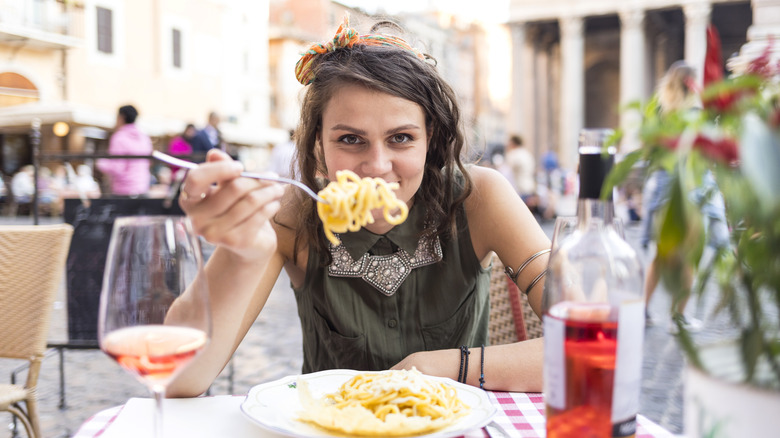The Lesser-Known Italian Town Chef Giada De Laurentiis Visits For The Best Pasta
When Giada De Laurentiis isn't at home, you might find her in Fara San Martino, enjoying hand-shaped pasta and basking in the green waters of the nearby nature preserve. The mountain spring water that runs through this town is the secret ingredient to its pasta's fame. Local producer Delverde says high-quality ingredients and the spring water from the Verde River "come together" to create what Laurentiis labels on her Giadzy website "the Italian capital of pasta." A popular chef and TV personality, Laurentiis was born in Rome and has embraced her Italian heritage throughout her esteemed culinary career — if she says Fara San Martino is a "must-visit for pasta lovers," then visit we shall.
Next time you head to Italy, avoid the crowds without missing any delicious pasta by following Laurentiis here. You'll come for the pasta but stay to explore the natural reserves and parks surrounding the town. Fara San Martino sits squarely in the Abruzzo region, backed up against the mountains of the gorgeous Majella National Park. Crystal-clear waters flow through pasta factories and springs just outside the town center, perfect for afternoon strolls and (of course) making world-class pasta. The town is three hours west of Rome (the best place to kick off a vacation in Italy), so spend a few days enjoying the Eternal City before zipping off to this area full of beautiful hikes, charming architecture, and locally sourced pasta.
Four world-renowned pasta companies call Fara San Martino home
Giada De Laurentiis isn't the only one who believes this area is the best place in the world for pasta. World-famous pasta manufacturers have factories surrounding Fara San Martino, sometimes just a quick walk from town. The most prominent company established locally is De Cecco, whose blue and yellow packaging you might recognize from your local supermarket at home. Other companies, like the previously mentioned Delverde, have named themselves and built their brands around Fara San Martino's natural beauty.
The best way to confirm these companies' — and Laurentiis' — opinions is to check out the town yourself. Fara San Martino is only three hours away from Rome by car, so you'll likely want to rent a car to head to this part of Italy, making it easier to explore the national parks. Set your GPS directly to the town square on Fara San Martino — from here, you won't have to search far for fresh pasta, and in this town, there are no tourist traps to avoid. Start with a heaping portion of chitarra, Abruzzo's specialty pasta shape. To most untrained North American eyes, it will look a lot like typical spaghetti, but Laurentiis explains on Giadzy that the square-shaped strands absorb more flavor from sauces than any other shape. Plan your trip for late August to arrive in time for the "Sagra della Pasta De Cecco," a two-day celebration of local pasta.
Walk off your meal in the Majella mountains
Fara San Martino's iconic pasta-making traditions are all about maximizing the natural resources that feed each plate, and you won't have to head far to see why. The quaint village backs up directly into more than 286 square miles of protected terrain in the form of national parks and nature preserves, and Fara San Martino is the perfect town to use as a base. Several hiking trails start in town and take you deep into the park, while other shorter walks take you through the Via Terra Vecchia, what Laurentiis refers to as "Ancient Lands." Some of Italy's earliest inhabitants lived amongst the caves, gorges, and grottoes in these parts, and remnants of buildings as old as the 10th century still stand there today.
Follow pedestrian pathways from town to places like the Sorgenti Del Verde, the springs where the green river emerges from the nearby mountains. Meander around pasta factories before winding up in the exact spot where clear water bursts out of limestone cliffs. The Monastery of San Martino is also worth checking out, where visitors can explore the ruins of a medieval monastery built under the protection of the San Martino gorge. These places are so close to downtown that you can try one type of pasta for lunch, wander off into nature, and get back in time for an authentic antipasti and a different pasta for dinner. Of course, this is Italy, so don't expect a quick dinner.


